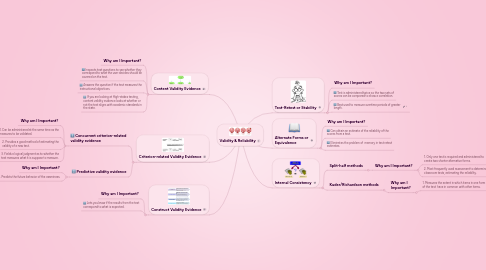Validity & Reliability
by melissa bova


1. Test-Retest or Stability
1.1. Why am I Important?
1.2. Test is administered twice so the two sets of scores can be compared to show a correlation.
1.3. Best used to measure overtime periods of greater length.
2. Alternate Forms or Equivalence
2.1. Why am I Important?
2.2. Can obtain an estimate of the reliability of the scores from a test.
2.3. Eliminates the problem of memory in test retest estimates.
3. Internal Consistency
3.1. Split-half methods
3.1.1. Why am I Important?
3.1.1.1. 1. Only one test is required and administered to create two shorter alternative forms.
3.1.1.2. 2. Most frequently used assessment to determine classroom tests, estimating the reliability.
3.2. Kuder/Richardson methods
3.2.1. Why am I Important?
3.2.1.1. 1. Measures the extent in which items in one form of the test have in common with other items.
4. Content Validity Evidence
4.1. Why am I Important?
4.2. Inspects test questions to see whether they correspond to what the user decides should be covered on the test.
4.3. Answers the question if the test measures the instructional objectives.
4.4. If you are looking at High-stakes testing, content validity evidence looks at whether or not the test aligns with academic standards in the state.
5. Criterion-related Validity Evidence
5.1. Concurrent criterion-related validity evidence
5.1.1. Why am I Important?
5.1.2. 1. Can be administered at the same time as the measures to be validated.
5.1.3. 2. Provides a good method of estimating the validity of a new test .
5.1.4. 3. Yields a logical judgment as to whether the test measures what it is suppose to measure.
5.2. Predictive validity evidence
5.2.1. Why am I Important?
5.2.2. 1. Predicts the future behavior of the examinees.
